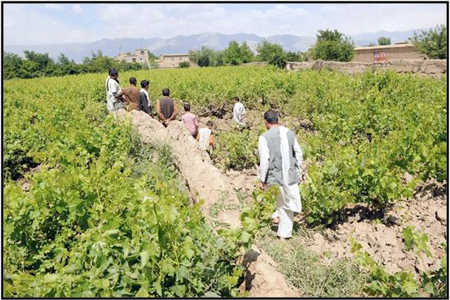KABUL -- On the 18th of May, as Hamid Karzai prepared to report on his notably successful visit to the United States, a suicide bomber in Kabul detonated his explosive-laden van, killing 6 coalition soldiers and 12 Afghan civilians, wounding nearly 50 others.
The New York Times aptly described the nightmarish scene: "An Afghan woman lay dead in her seat, cut in half, with her baby still squirming in her arms. . . . a man's head lay on the hood of a truck."
Reminds one of a cross between Hieronymous Bosch and Salvador Dali.
The next day, about 30 to 40 Taliban launched a feeble attack on Bagram Air Base, wounding nine soldiers (three returned to duty shortly after) and killing a contractor.
An Agency France Presse photo shows Afghans inspecting the site of one suicide bomber's Bagram attack: Afghan villagers are in a field of weeds. Bagram is nowhere in sight.

The Los Angeles Times reports that "the Taliban . . . appears determined to show strength and build prestige . . . to telegraph resiliency."
Saturday night, the Kandahar Airfield received multiple indirect fire rounds and a small number of insurgents attempted to enter the base but were repelled by security forces. The indirect fire wounded several ISAF personnel and civilian workers, but there were no fatalities, and the insurgents did not penetrate the base perimeter.
The Wall Street Journal reported Monday that "until Saturday insurgents hadn't mounted any coordinated assaults there," recognizing "heavy losses" but characterizing the bungle a "bold attack."
Perhaps news of apparently coordinated attacks might give overly-optimistic sideline-sponsors reason to pour some funds in Taliban coffers to draw out just a little longer the inevitable conclusion.
And self-annihilation might seem prestigious to vulnerable, misguided glory-seeking youngsters.
But what effect do these attacks have?
None.
Really, none.
Consider the broader context.
The combined Afghan-Coalition comprehensive counterinsurgency strategy is turning the momentum of the fight. That strategy is based on the fundamental principle not of chasing insurgents around, but of protecting the Afghan people.
About 40,000 more coalition soldiers will be here helping protect the Afghan people by August.
In Washington alongside President Karzai - and to the dismay of insurgents believing July 2011 marks open-season on Afghan people - President Obama announced, "We are not suddenly . . . finished. . . . this is a long-term partnership." He said, "We are still going to have an interest in making sure that Afghanistan is secure, that economic development is taking place, that good governance is being promoted."
The Consultative Peace Conference is on the horizon, and the Kabul Conferences, sequel to the London Conferences, follows shortly after.
The Afghan government has a ways to go to more productively and consistently respond to the needs of its citizens. But they are working harder at it, and the international community is right here beside them.
Parliamentary elections are in September, just after Ramadan, giving the people opportunity, once again, to shape their future.
And rumors of Afghan-led reconciliation and reintegration policies that hang in the air are hard to ignore.
After more than three decades of turmoil, pain and loss, the Afghans are tired. We suspect the majority of Taliban fighters that will die in vain rather than enjoy a growing opportunity for prosperity are tired as well.
Indeed, there will likely be more violence before it gets better as Afghan National Security and Coalition forces expand into places previously unsecure.
But what we are seeing from the insurgents is a string of unequivocal Taliban tactical failures and progressively strategic-level blunders.
The attacks are significant, do not misread.
Significant to families losing loved ones. Significant to soldiers losing friends. Significant to those maimed and suffering for the rest of their lives.
And significant to little Afghan boys and girls whose mothers are chopped in half.
Certainly, the more the Taliban blow themselves up and hurt others the more they antagonize the Afghan people, the more they marginalize themselves and their cause.
But by guessing at some message to their brutality -- rather than accentuating the utter fiasco these attacks represent -- we help ascribe meaning to the meaningless and order to their nihilism.
Remember that image - remnants of an insurgent, emissary of nihilism, blown to pieces in a lonely field of weeds in an act of grossest futility.